Dancing with Allison
Sep 7, 2009
A single picture doesn't tell the whole story, but it looks like it was a pretty good party. And although Ted has cut his hair since then, I'm guessing he can still dance.

Sep 7, 2009
A single picture doesn't tell the whole story, but it looks like it was a pretty good party. And although Ted has cut his hair since then, I'm guessing he can still dance.

Oct 23, 2009
That's me with the chisel in my mouth, some summers ago, during geologic field work in the North Cascades, in the state of Washington. I'm climbing a hill called Lincoln Rock that rears up about twelve hundred feet above the apple orchards along the banks of the Columbia River. We'd been told there were some good garnet coronas up there--garnets with white rings around them---the metamorphic feature I was trying to interpret for my thesis project.
We'd also been told that Lincoln Rock was the one place in the North Cascades where a geologist named Bob Miller--a man who climbed cliffs for fun when he couldn't think of an excuse to climb them for research--fell badly and almost cracked his head open. This was my last day in the field that summer, and though I'd had wonderful fun, I was beginning to shift gears mentally, to look forward to getting back home so I could stop worrying about slipping and falling and leaving five children motherless.
Perhaps because of Bob's misadventure, but surely also because I was old and out of shape, I was by far the slowest climber. While I toiled upward inch by inch in the August sun, the rest of the gang was already lolling about in the shade of an overhang at the top of the hill, eating lunch and making fun of me. As I finally approached the scene of this snapshot, a Ph.D. student named Carlos Zuluaga asked if I wanted my picture taken. Then he suggested I put the chisel in my mouth. It seemed like a good idea at the time, it really did.
Anyway, there were indeed nice-looking garnet coronas all over the hilltop, and Carlos and the others kindly helped me smash them out of the outcroppings. We all made it down safely, with rocks in our backpacks. When I got a look at my Lincoln Rock samples under the microscope, however, I discovered that the garnets were rotten; they'd cooled too slowly after their metamorphic odyssey, and a mineral named chlorite had replaced much of the garnet. My thermodynamic models wouldn't work on rock with rotten garnet, so I put the Lincoln Rock samples in a drawer in the basement of the geology building, and maybe they are still there today.
Fortunately, I had plenty of other samples. And I'd love to be back up there again.....
Feb 7, 2010
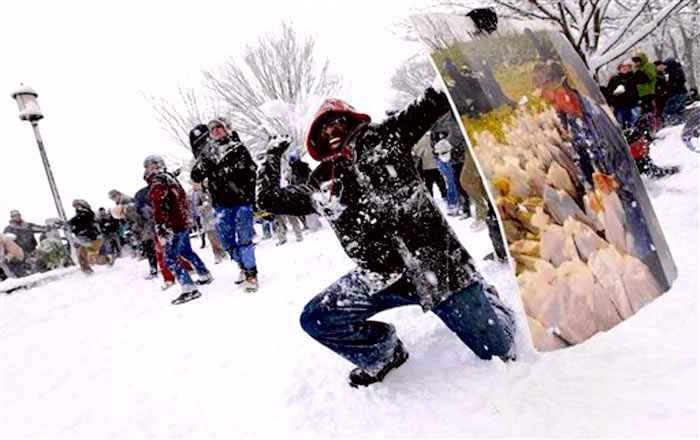
Only in Washington, D.C., in the year 2010, does a snowball fight feature lawyerly liability disclaimers, new-media marketing, and streaming traffic reports.
A heavily promoted snowball fight at Dupont Circle on Saturday attracted about two thousand participants, most of them adults, even though the snow was said to be too fluffy for decent snowballs. For every actual snowball thrower there appear to have been several would-be cell phone videographers, whose work may be assessed on YouTube. Six police cars waited nearby, but nothing happened. Some people attacked the fountain in the center of the circle by throwing snow at the people defending the fountain; the fountain is still there, so perhaps the defenders "won."
Facebook pages and Twitterings promoted the event. Lawyers were involved; a disclaimer on Facebook warned: "You are coming to Dupont Circle Park on Saturday, Feb 6, 2010, to play snowballs voluntarily. The people spreading the word about the happening are not preparing any special equipment or conditions and may not be held responsible for your decisions and/or actions."
Radio station WTOP broadcast warnings to motorists, urging them to avoid Dupont Circle and other snowball-fight locales. Although the Dupont Circle "fight" attracted the most attention, Washingtonians apparently were out pelting one another with snow all over town. This picture came from some allegedly voluntary snow play in Meridian Hill Park, where an artist was using an old piece of artwork as a shield.
May 13, 2010
In 1930, a lacrosse team made up of players from both Oxford and Cambridge toured the United States, taking on all comers and thrashing them. Apparently, many of the Oxford-Cambridge stickmen were Americans studying abroad, including a number of Rhodes Scholars who had excelled at lacrosse during their undergraduate years.
Only one American team beat Oxford-Cambridge that season: the St. Johnnies from Annapolis, Maryland, shown here in short-shorts posing with the jacketed Englishmen in front of Washington, D.C.'s Central High School, where the game was played. St. John's won, 7-0.
St. John's College is now a super-intellectual "great books" school where students study the classics in the original Greek and have no time for intercollegiate sports. Every year, however, they do schedule one game against the athletic powerhouse located across the street from their campus in Annapolis, and they usually win handily. The game they play is croquet, and their opponents are the midshipmen of the U.S. Naval Academy, who complain that the Johnnies have all year to practice croquet, while midshipmen have to march and run and shine shoes and do all that other time-consuming navy stuff.
Feb 4, 2011
 Last night, senior midshipmen at the U.S. Naval Academy participated in Ship Selection to determine their first assignments after graduation in May. The names of ships in need of junior officers were posted on the wall, listed under the names of their home ports. One at a time, beginning with the midshipman at the top of the class, the students walked up to the wall of options and claimed their billets.
Last night, senior midshipmen at the U.S. Naval Academy participated in Ship Selection to determine their first assignments after graduation in May. The names of ships in need of junior officers were posted on the wall, listed under the names of their home ports. One at a time, beginning with the midshipman at the top of the class, the students walked up to the wall of options and claimed their billets.
Allen chose the USS Ingraham, pictured here at its home port, Naval Station Everett, on Puget Sound north of Seattle. This year there were only nine billets available in Everett, which is generally a popular home port option; it was Allen's first choice. Many of his classmates chose ships in Florida, Hawaii, or San Diego.
The Ingraham, a frigate, is the gray ship in the middle. Mount Baker is the snow-covered volcano in the background.
Mar 27, 2011
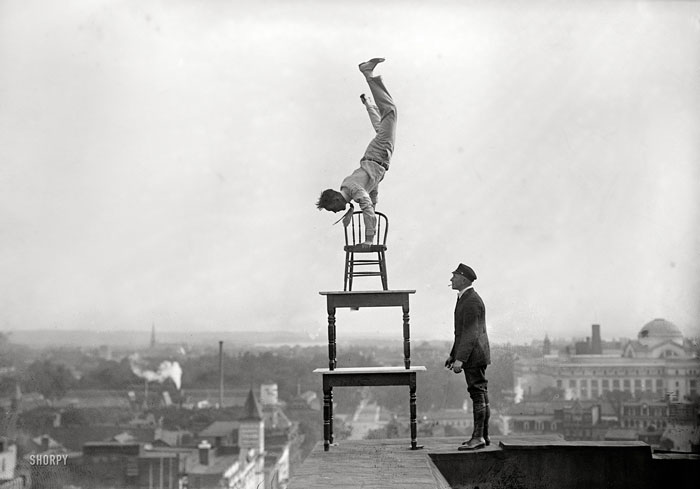 In 1917, guy by the name of Jug Reynolds was trying to make a living doing this sort of thing–standing on his hands on top of a chair on top of two tables on top of the cornice at the edge of the roof of Lansburgh's furniture store at 9th Street and F Street NW in Washington, D.C.
In 1917, guy by the name of Jug Reynolds was trying to make a living doing this sort of thing–standing on his hands on top of a chair on top of two tables on top of the cornice at the edge of the roof of Lansburgh's furniture store at 9th Street and F Street NW in Washington, D.C.
Note that Jug's helper out there on the roof had a cigarette in his mouth. All in a day's work.
The domed building in the background is the Smithsonian Museum of Natural History.
Jul 23, 2011
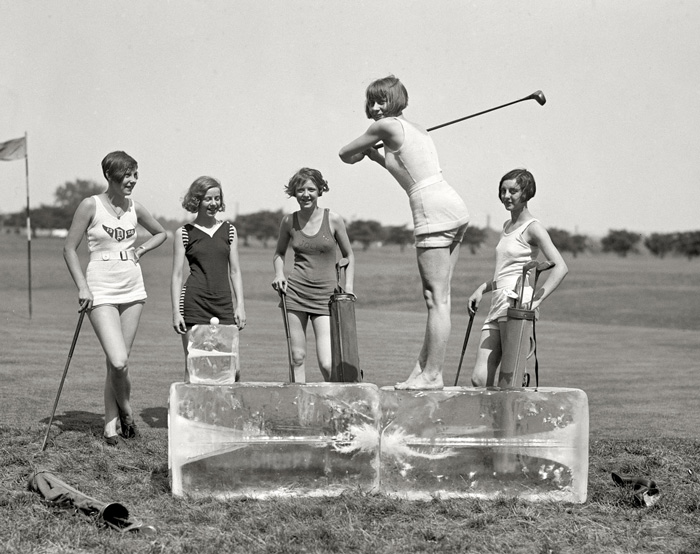 On July 11, 1926, the Washington Post published this publicity shot for "the Gladyse Wilbur girls," a song-and-dance troupe that did its singing and dancing, as well as its teeing off, in bathing costumes. That's Dorothy Kelly on ice, backed up by Virginia Hunter, Elaine Griggs, Hazel Brown, and Mary Kaminsky.
On July 11, 1926, the Washington Post published this publicity shot for "the Gladyse Wilbur girls," a song-and-dance troupe that did its singing and dancing, as well as its teeing off, in bathing costumes. That's Dorothy Kelly on ice, backed up by Virginia Hunter, Elaine Griggs, Hazel Brown, and Mary Kaminsky.
The show was in Keith's Theater in Washington, which may have been air conditioned by 1926. The ice in the photo is obviously intended to suggest that the Gladyse Wilbur girls can be enjoyed in cool comfort, even in the middle of the summer.
Sep 21, 2011
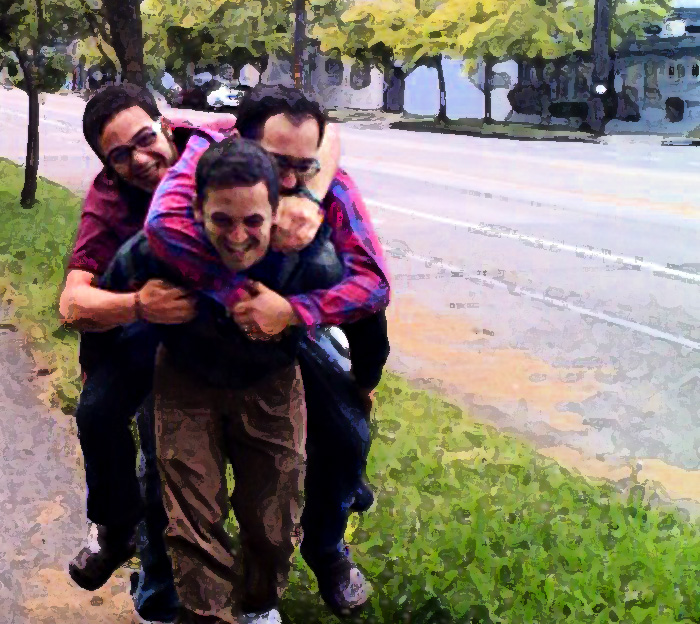 Stein boys doing their brotherly whatever on the street last summer in Seattle. From the bottom: brothers number 4, 1, and 5.
Stein boys doing their brotherly whatever on the street last summer in Seattle. From the bottom: brothers number 4, 1, and 5.
Sep 24, 2011
Sep 28, 2011
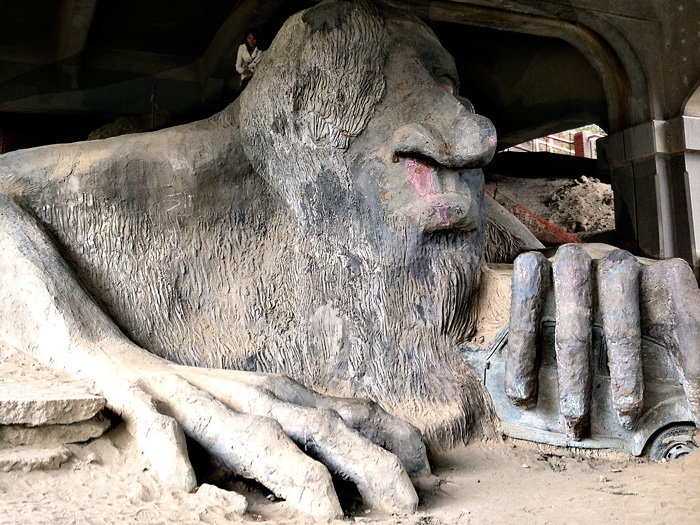 There's a troll underneath the Fremont bridge in Seattle, with a Volkswagen in its grip. The three billy goats gruff, in rusty cast iron, are grazing on a church lawn a couple of blocks away, at the corner of Troll Avenue and 35th Street.
There's a troll underneath the Fremont bridge in Seattle, with a Volkswagen in its grip. The three billy goats gruff, in rusty cast iron, are grazing on a church lawn a couple of blocks away, at the corner of Troll Avenue and 35th Street.
Nov 18, 2011
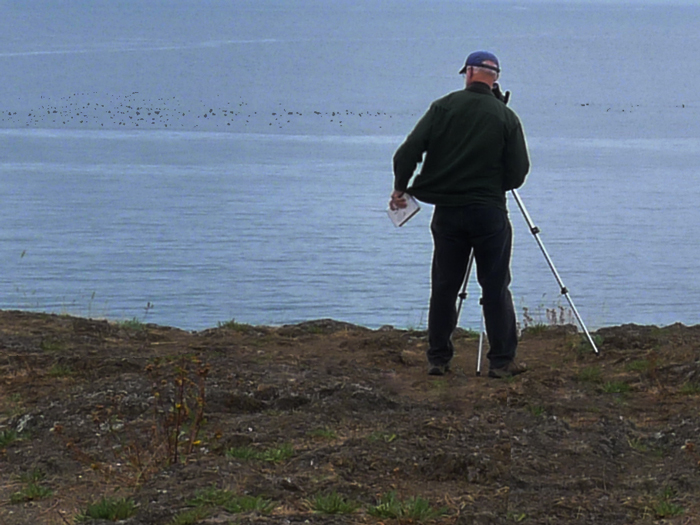 He had driven a thousand miles for the chance to set up his scope at Deception Pass, on Puget Sound about an hour north of Seattle. But the notebook in his left hand received no new entries; he saw birds, to be sure, but he'd seen them all before. The only thing he saw that day of even mild ornithological interest was the long line of black dots way out at sea–they were grebes, he told us, a very common waterbird, but a kind that didn't usually flock together so massively; there were hundreds of grebes out there on the tide, he estimated, bobbing and diving, more by far than he'd ever seen in one place before.
He had driven a thousand miles for the chance to set up his scope at Deception Pass, on Puget Sound about an hour north of Seattle. But the notebook in his left hand received no new entries; he saw birds, to be sure, but he'd seen them all before. The only thing he saw that day of even mild ornithological interest was the long line of black dots way out at sea–they were grebes, he told us, a very common waterbird, but a kind that didn't usually flock together so massively; there were hundreds of grebes out there on the tide, he estimated, bobbing and diving, more by far than he'd ever seen in one place before.
The Audubon Society reports that grebes are pretty standard inhabitants of Deception Pass and thereabouts, along with mergansers, cormorants, black oystercatchers, alcids, and common and Pacific loons. But the big ornithological draw, especially in the wintertime, is the red-throated loon. Maybe this birdwatcher will schedule another trip when the weather is a whole lot worse.
Jun 3, 2012
 In 1920, this was Dead Man's Curve on the main highway connecting Washington and Baltimore. The small sign in the middle of the photo, just beyond the wooden guard rail, reads "Danger."
In 1920, this was Dead Man's Curve on the main highway connecting Washington and Baltimore. The small sign in the middle of the photo, just beyond the wooden guard rail, reads "Danger."
Route 1 was rerouted in the 1940s to avoid the danger.
Aug 2, 2012
 Our son John Stein and Bonnie Strelitz were married last weekend in Seattle. I don't remember the rings sparkling quite this much, but the sun was smiling and the stars all a-whispering their warmest good wishes.
Our son John Stein and Bonnie Strelitz were married last weekend in Seattle. I don't remember the rings sparkling quite this much, but the sun was smiling and the stars all a-whispering their warmest good wishes.
Aug 10, 2012
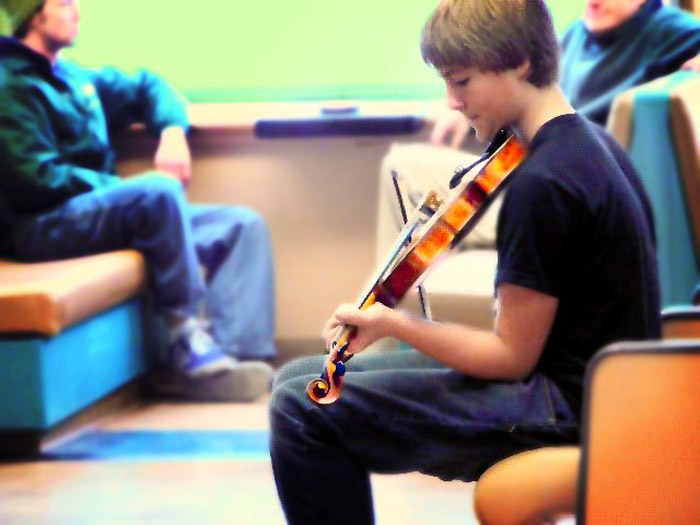 At the feet of the fiddler in this picture is his open violin case, with a hat in it. He is riding the Washington State ferry that crosses Puget Sound between Edmonds and Kingston, just north of Seattle. I don't know if he's trying to make a living this way or just hoping to pull in a few bucks or simply earning back his ferry fare as he rides the water. It's also possible that he's doing this because he lost a bet. Whatever, this crossing had a soundtrack that I used to believe was better suited to trains than to boats: Foggy Mountain Breakdown and Orange Blossom Special.
At the feet of the fiddler in this picture is his open violin case, with a hat in it. He is riding the Washington State ferry that crosses Puget Sound between Edmonds and Kingston, just north of Seattle. I don't know if he's trying to make a living this way or just hoping to pull in a few bucks or simply earning back his ferry fare as he rides the water. It's also possible that he's doing this because he lost a bet. Whatever, this crossing had a soundtrack that I used to believe was better suited to trains than to boats: Foggy Mountain Breakdown and Orange Blossom Special.
(Reposted from a 7 November 2008 posting to an antediluvian ancestor of this blog.)
Sep 1, 2012
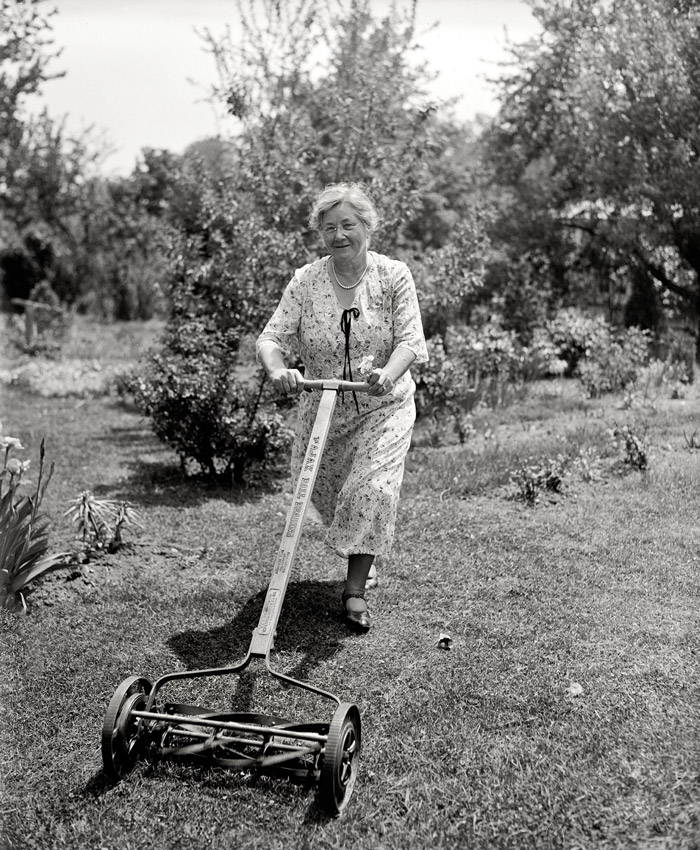 In the archives of the old Harris & Ewing photo studio in Washington, D.C., is the glass negative for this picture, with no caption information whatsoever.
In the archives of the old Harris & Ewing photo studio in Washington, D.C., is the glass negative for this picture, with no caption information whatsoever.
What think you? A posed shot to promote new lawnmowers with Ajax Ball Bearings? Political imagery to promote a candidate with hard-working American (grass)roots? Somebody's aunt?
1920s? 1940s?
Couple of thoughts: Years ago, we lived in a neighborhood of Tuscaloosa, Alabama, where most of our neighbors were older people. By then, lawnmowers had gasoline engines, but I recall that pushing them was considered women's work. More recently, when we lived in Maine, I often saw older couples out in the morning clearing their walks with gasoline-powered snowblowers. The division of labor for this task was that the man walked behind the snowblower while the woman worked alongside with a shovel.
What I like best about this picture: the pearls.
Sep 7, 2012
 At John and Bonnie's wedding this summer, guests were encouraged to pose for pictures in a photo booth. The people in these shots are pretty much all related to me in some way or another, most through marriage, either mine or my son's.
At John and Bonnie's wedding this summer, guests were encouraged to pose for pictures in a photo booth. The people in these shots are pretty much all related to me in some way or another, most through marriage, either mine or my son's. 
Sep 22, 2012

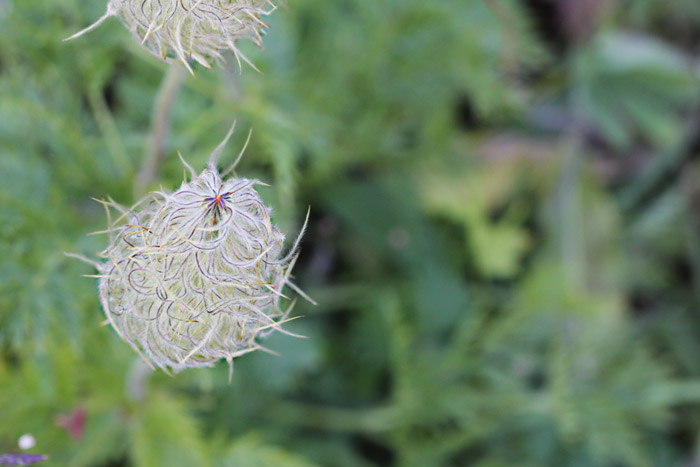 There are good things to say about summertime, but there's also this: it was too damn hot. The air finally feels fresh and pleasant at this new-beginning time of year, even if I've had the same song in my head now for forty-one Septembers. . . .
There are good things to say about summertime, but there's also this: it was too damn hot. The air finally feels fresh and pleasant at this new-beginning time of year, even if I've had the same song in my head now for forty-one Septembers. . . .
Nov 29, 2012
 The landlord told the tenants in this little house in Seattle that the place needed painting, and that he and his guys would be taking care of it. And it was true, apparently, that it needed painting, and also true that the landlord and his guys came over recently to do the work.
The landlord told the tenants in this little house in Seattle that the place needed painting, and that he and his guys would be taking care of it. And it was true, apparently, that it needed painting, and also true that the landlord and his guys came over recently to do the work.
The job took two weeks. They painted a sunrise on this side of the house, and a sunset on the other side. Before then, both sides had been plain and gray.
The tenants say they like the house and they like the landlord, and it will take a lot more than this to get them to leave.
Dec 19, 2012
 Obviously worth a trip downtown, in Spokane, Washington.
Obviously worth a trip downtown, in Spokane, Washington.
Mar 23, 2013
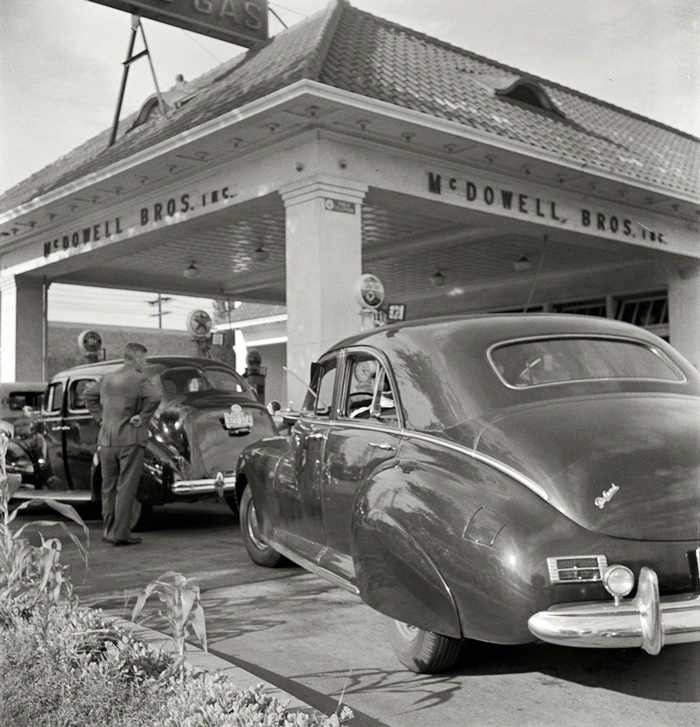 By 7 a.m. on June 21, 1942, the line of cars at this Texaco station, and at pretty much every gas station in America, spilled out of the lot and on down the street. Strict gas rationing to conserve fuel for the war effort was set to begin the next day, June 22, 1942.
By 7 a.m. on June 21, 1942, the line of cars at this Texaco station, and at pretty much every gas station in America, spilled out of the lot and on down the street. Strict gas rationing to conserve fuel for the war effort was set to begin the next day, June 22, 1942.
Note the corn plants growing in the grassy spot in the lower left corner of the picture. Note also the car closest to the camera: a brand new 1942 Packard.
McDowell's Texaco was in the 5200 block of Wisconsin Avenue NW, near Friendship Heights at the edge of Washington, D.C; a parking garage now occupies the spot.
Sep 8, 2013
 It's gotta be that shredder sitting by the windowsill, just to the right of the desktop.
It's gotta be that shredder sitting by the windowsill, just to the right of the desktop.
This is Ted's new office in Washington, DC.
Jun 21, 2014
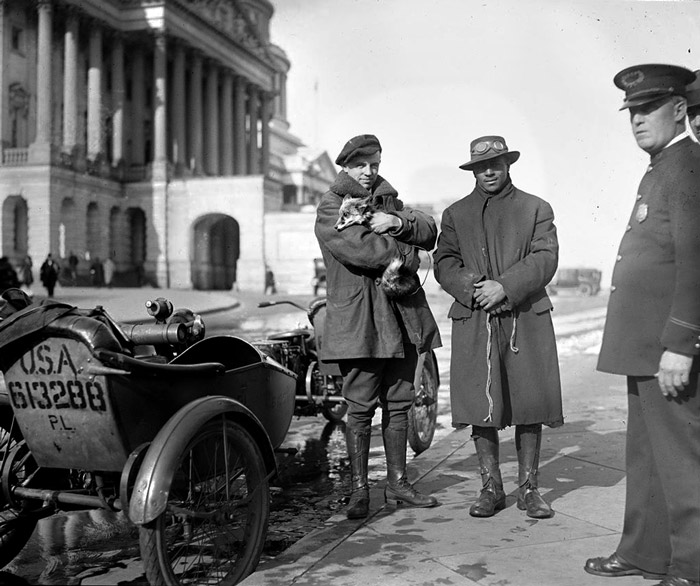 Men standing around in front of the U.S. Capitol building, holding a fox, 1919.
Men standing around in front of the U.S. Capitol building, holding a fox, 1919.
This photo comes from the files of the Office of the Architect, U.S. Capitol. The backstory is not known to us, but apparently foxes are observed from time to time roaming the grounds of the Capitol, feasting on squirrels. Just last February, tourists noted exactly that, and the Washington press corps twittered all about it.
Dec 29, 2014
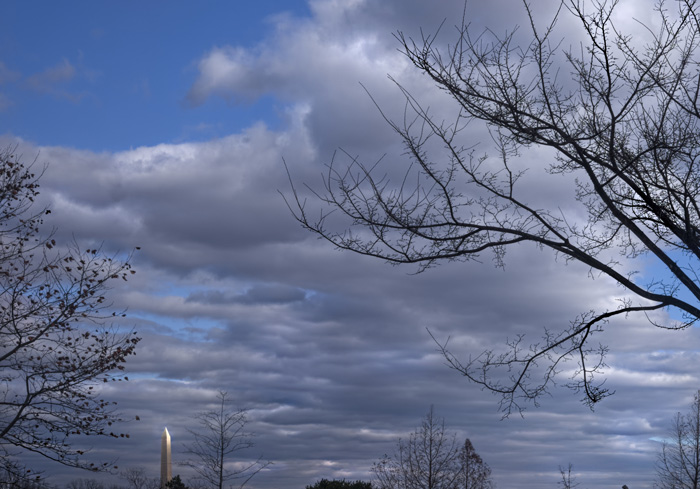 The only skyscraper in the city of Washington, as glimpsed from Arlington National Cemetery.
The only skyscraper in the city of Washington, as glimpsed from Arlington National Cemetery.
Jan 4, 2015
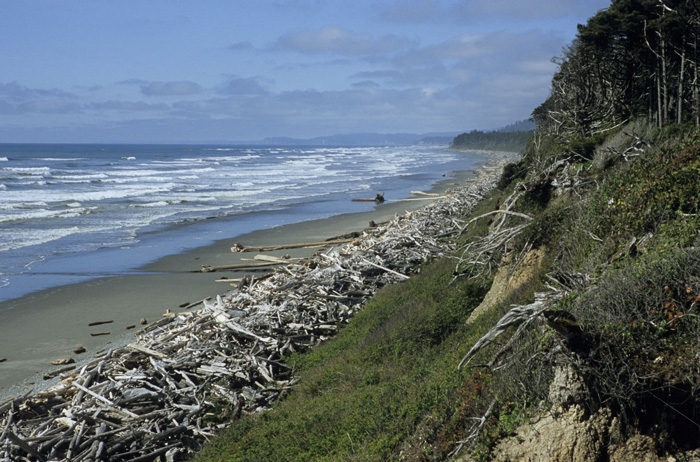 Pacific Ocean beach near Kalaloch, in Olympic National Park.
Pacific Ocean beach near Kalaloch, in Olympic National Park.
Driftwood arrives naturally on beaches in the Pacific Northwest; storms, erosion, and ordinary old age can cause trees growing in thin soil on steep slopes to tumble down into inland creeks and rivers; when the rivers are running high and fast, entire forests can be floated right on out to the coast.
Jan 29, 2015
 When last we spent our Saturdays at high school wrestling tournaments, back in the decade of the twenty-oughts, we were parents of wrestlers, which meant that we were working the concession stand or down on our knees with a camcorder or scanning the scene from the bleachers, looking for indications of wrestling drama.
When last we spent our Saturdays at high school wrestling tournaments, back in the decade of the twenty-oughts, we were parents of wrestlers, which meant that we were working the concession stand or down on our knees with a camcorder or scanning the scene from the bleachers, looking for indications of wrestling drama.
We can report with confidence that in the winter of 2015, all the drama is still much in evidence. Even before you enter the gym, you can't help but notice the kid standing all by himself out in the cold parking lot, hiding his face, struggling not to cry.
The only big difference nowadays is that somehow, magically, our wrestlers from way back then have returned to this scene as what might be called wrestling facilitators. One of them is now a referee with striped shirt and whistle, and another is an assistant assistant coach, a guy who sits in the corner of the mat during each bout and yells, "Circle! Circle! Good–keep that elbow. That's all right, don't worry, now up and out!"
High school wrestling matches last six minutes, except when they're over in a few seconds. That can happen when a newbie, with panic in his eyes, is up against an experienced wrestler who knows a few moves. Of course it can also happen when an experienced wrestler underestimates an opponent, or when he forgets for an instant to do or not do something critical that he knew perfectly well he was supposed to do or not do.
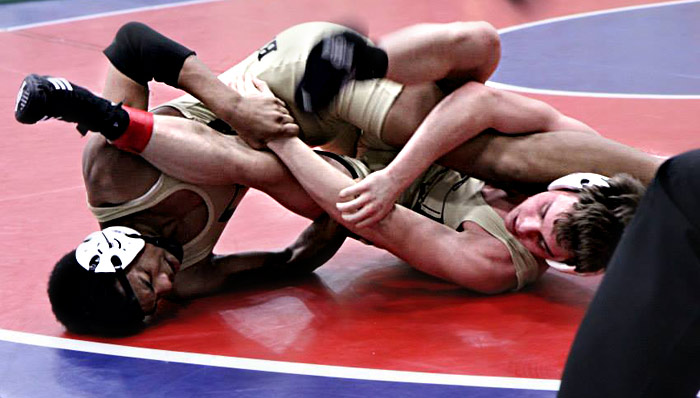
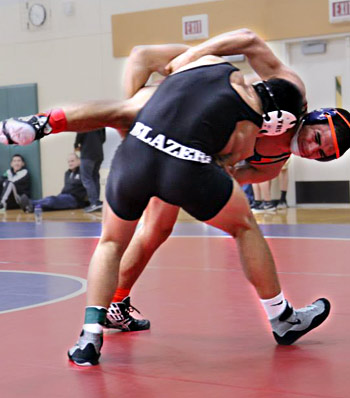
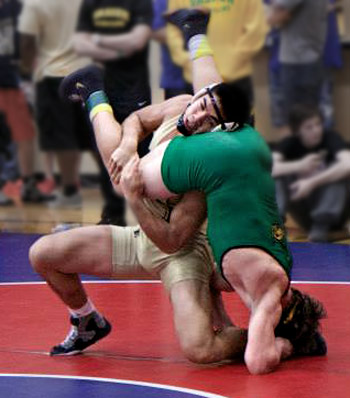
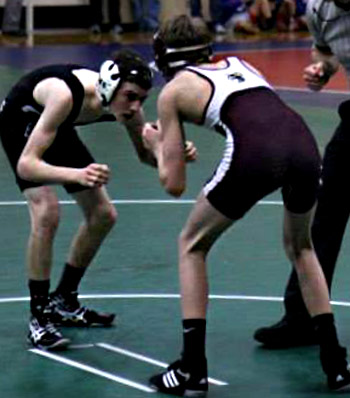

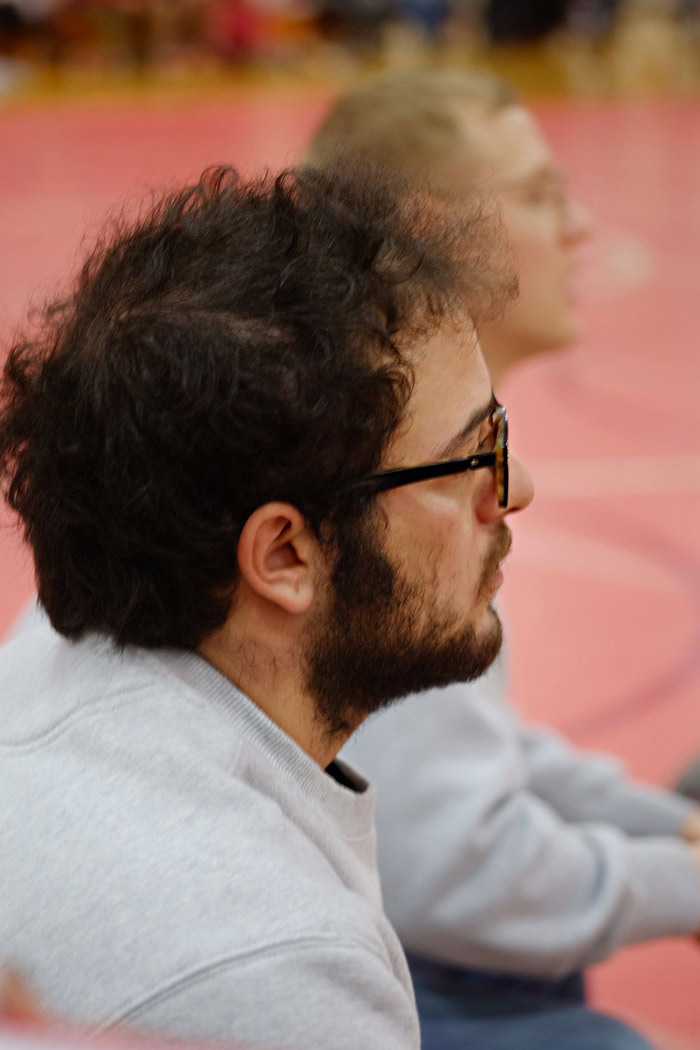
Feb 14, 2015
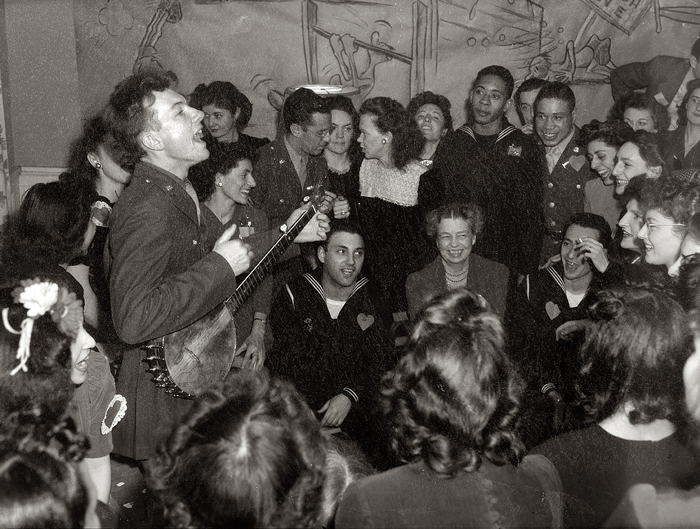 Guest of honor at this Valentine's Day party in 1944 was Eleanor Roosevelt; serenading her was a soldier by the name of Pete Seeger.
Guest of honor at this Valentine's Day party in 1944 was Eleanor Roosevelt; serenading her was a soldier by the name of Pete Seeger.
The gathering celebrated not only Valentine's Day but also the grand opening of the new Labor Canteen of the United Federal Workers of America, CIO, near Dupont Circle in Washington, D.C.
United Federal Workers was a labor union representing U.S. government employees. Though soldiers and sailors were certainly not unionized, they may have frequented the new canteen for political and/or social activities.
The UFW included both black and white members. But the scene in this room was extremely unusual for 1940s Washington, which was still a completely segregated city. The military was also still segregated. Eleanor Roosevelt's presence was making a political statement about race as well as labor.
The cartoons on the wall in the background may have been the work of Woody Guthrie.
As some of you will surely point out, the banjo Pete Seeger is playing here does not look like the long-necked music machine he was long associated with. That one came a few years later.
Happy Valentine's Day 2015.
Feb 21, 2016
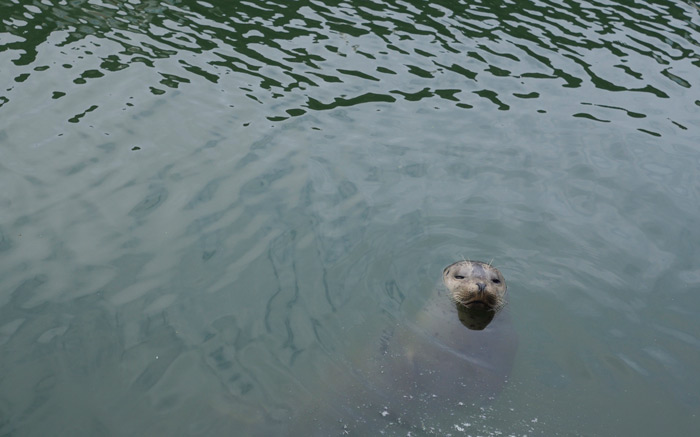 One of the hangers-on at a marina near Everett, Washington, pokes his head up from the waters of Puget Sound in hopes that the incoming salmon-fishing charter boats had a good day.
One of the hangers-on at a marina near Everett, Washington, pokes his head up from the waters of Puget Sound in hopes that the incoming salmon-fishing charter boats had a good day.
Apr 3, 2016
 This fence is part of the security for Naval Base Kitsap–Bangor, home to eight submarines armed with Trident nuclear missiles.
This fence is part of the security for Naval Base Kitsap–Bangor, home to eight submarines armed with Trident nuclear missiles.
The deer are apparently not a security issue, but drones, on the other hand, are becoming a big problem. Multiple drone flights over the base been reported, all taking place at night, and nobody knows who is flying the drones or why.
Naval investigators have yet to solve the mystery. Nearby residents have been interviewed, but their involvement is doubtful. "I really can't imagine any of the neighbors or neighbors' kids thinking it's OK to run drones over Bangor," said one area resident who'd been interrogated about the incidents. "Everyone here is very aware that this is one of the most lethal places on earth."
Signs around the base perimeter warn "Keep Out. Use of force authorized."
Jun 14, 2016
 The prairie lands around the southern end of Puget Sound were created by ice and sustained by fire.
The prairie lands around the southern end of Puget Sound were created by ice and sustained by fire.
Retreating glaciers some ten thousand years ago left behind vast stretches of land scraped bare of trees, initially supporting only grasses and other low-lying scrub, in a climate generally so humid that grassland would normally yield to forest. Much of this post-glacial prairieland did revert to forest, but by burning off the old growth every spring, Native peoples prevented tree seedlings from taking root and thus maintained many thousands of acres as grassland for grazing their horses and other livestock.
However, the prairies of Western Washington were the first land grabbed by invading Europeans; lacking tree cover, they were ready-made for cropland and pasture. Farms and cities grew. The ancient practice of annual burns was abandoned, and big trees were soon thriving.
Only a few tiny remnants of these prairies remain, grassy islands in a sea of trees, and they are ecologically degraded now to varying extents. Much of the remaining acreage is entrusted to the Center for Natural Lands Management, a nonprofit that attempts to restore and preserve the South Sound prairies. Annual burning regimes have been reinstated.
Above is a bit of the grass in Glacial Heritage Preserve, a prairie in Thurston County, Washington, that is open to the public only on volunteer work days.